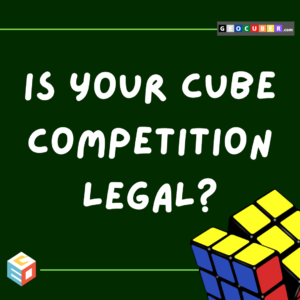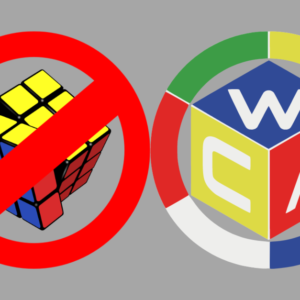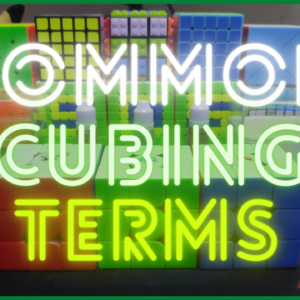
Are you tired of getting the same results during your solves in a WCA competition? Why don’t you try to DNF your solves instead? Here’s a list of 18 things you can do to disqualify your attempts in an official WCA competition.
Note: A7g) At the discretion of the WCA Delegate, an incident or penalty caused by a new competitor’s inexperience may be replaced with an extra attempt.
General
Camera Use [2i2]
Competitors may use cameras at the solving station at the discretion of the WCA Delegate, but the following restrictions apply from the start of the attempt until the competitor stops the solve.Yes! Using cameras for video recording is allowed but each camera monitor must be blank or out of sight of the competitor and the competitor must not interact with (e.g. operate, hold, wear) any active camera. The competitor may wear a camera mounted on their head, as long as it is out of their sight and it is clear that they are not interacting with it (apart from wearing it).
Puzzle Approval [3k]
Puzzles should be approved by the WCA Delegate before use in the competition.If a non-permitted puzzle is found during a round, the competitor must not continue to use the puzzle, and must submit a replacement. For attempts done with puzzles which are not permitted, a “disqualification of the attempt (DNF)” penalty will be given. There are some exceptions though. If a non-permitted puzzle is found before a round is complete, affected results in the round may be replaced with extra attempts, at the discretion of the WCA Delegate. In 3x3x3 Multi-Blind, if any puzzles are found to be non-permitted, such puzzles may be individually counted as unsolved (without disqualifying the entire attempt), at the discretion of the WCA Delegate.
Puzzle Defects [5b1]
If a competitor chooses to repair the puzzle, they must repair only the defective parts. Tools and/or parts of other puzzles must not be used to repair the original puzzle.Puzzle defects often happen in competitions. These include popped parts, pieces twisted in place, detached screws/caps/stickers, etc. If a puzzle defect occurs during an attempt, the competitor may choose to either repair the defect and continue the attempt, or to stop the attempt. Repairs must not be done using tools or parts of other puzzles. And if the puzzle is found to be unsolvable after a repair, the competitor may disassemble and reassemble a maximum of 4 pieces to make the puzzle solvable.
If the puzzle is unsolvable, and can be made solvable by rotating a single corner piece, the competitor may correct the corner piece by twisting it in place without disassembling the puzzle. Any repair to a puzzle must not give the competitor an advantage in solving the puzzle. Therefore, twisting corners deliberately to skip or shorten the OLL execution (for example) is a ground for attempt disqualification (DNF).
Inspection Time [a3c1]
The competitor must not apply moves during inspection.Communication During a Solve [a5a]
While inspecting or solving the puzzle, the competitor must not communicate with anyone other than the judge or the WCA Delegate.Through communication, a competitor may receive information that may give them an advantage during the solve. It may also distract other competitors who are doing their solves. Receiving assistance from anyone or any object is a ground for disqualification of the attempt (DNF). Although the surface of the table can be be considered as an object, the competitor may hold the puzzle against the surface [of the table] to help operate the puzzle.
Release the Puzzle [a6c]
The competitor must fully release the puzzle before stopping the timer.In other words, make sure that your hands are not in contact with the puzzle anymore when the timer stops. If the puzzle was not released but no moves have been applied after stopping the timer and before releasing the puzzle, a time penalty (+2 seconds) may be assigned instead, at the discretion of the judge.*
Additional Moves [a6ea]
After stopping the timer, the competitor must not touch or apply a move to the puzzle until the judge has inspected the puzzle.The attempt will be disqualified (DNF) if a move is applied to the puzzle after stopping the timer. If the competitor only touched the puzzle (no move applied) after stopping the timer a +2 seconds time penalty is given. But if immediately after stopping the timer, the competitor briefly touches the puzzle without affecting its state, the time penalty may be lifted, at the discretion of the judge.
Timer Reset [a6f]
The competitor must not reset the timer until both the competitor and the judge have signed the score sheet.*Important: If the competitor resets the timer before the result has been completely recorded, the judge must not write down the result from memory or from video or photographic evidence, and must disqualify the attempt instead (DNF).
Blindfolded Solves
Making Notes [b3b]
[In BLD] the competitor must not make physical notes.Memorization Phase [b3c]
[In BLD] the competitor must not apply moves to the puzzle during the memorization phase.If the parts of the puzzle are not fully aligned, then the competitor may align the faces, as long as misalignments stay within the limits acceptable.
Blindfolded Phase [b4d]
[In BLD] the competitor must not look at the puzzle at any point during the blindfolded phase.Blindfolded Repairs [5b4]
During a blindfolded phase, all repairs must be performed blindfolded.Removal of Blindfold [b5c]
[In BLD] if the competitor is not touching the puzzle, they may remove the blindfold before they stop the timer. They must not touch the puzzle until the end of the solve.Special Solves
One-Handed Solving [c1b]
[In OH] during the solve, the competitor must use only one hand to operate the puzzle.Once a competitor operates the puzzle with one hand, they must not operate the puzzle with the other hand. If a puzzle defect occurs, and the competitor chooses to repair it, they must repair it using only the solving hand. If other body parts of the competitor come in contact with the puzzle or parts of the puzzle without the competitor’s intention and without applying moves, this is not considered operating the puzzle.* During the solve, the competitor may hold the puzzle against the surface [of the table] to help operate the puzzle.
Fewest Moves Solving [e2a1]
[In FMC] before the attempt has begun, the competitor must not write on any paper intended for the attempt.The competitor may write information to identify the attempt but if they write this information on the paper that contains the scramble sequence, they must write only on the side without the scramble sequence before the attempt. Information to identify the attempt is: the competitor’s name, WCA ID, or competition registrant ID (at least one, optionally multiple), and optionally the competition name, round, or attempt number. A submitted solution without name, WCA ID, or competition registrant ID will be considered as DNF or disqualified. The [FMC] solution must be a single unambiguous move sequence with each individual move written out in sequential order. An ambiguous solution is a ground for disqualification of the attempt (DNF). Most importantly, the competitor’s solution must not be directly derived from any part of the scramble sequence.**
Clock Solving [f3]
[In Clock] at the end of the inspection period, the competitor places the puzzle in a standing position.Clock Inspection [f3a]
The competitor must not change the positions of any pins from their scrambled positions before the start of the solve.MBLD Inspection [h1e]
The competitor must not apply any moves to one or more puzzles during the memorization phase.You might also want to read: 10 Ways To Get Disqualified From A WCA Competition






